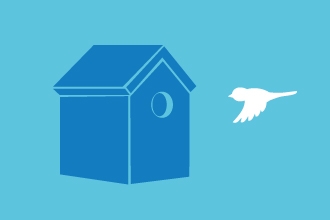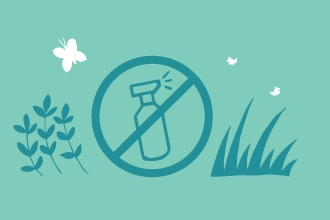
Wildlife Gardening in BS3
The Willmott Family in Bedminster
Tom Willmott and his family in Bedminster have turned their urban garden into a wildlife haven, by making easy and effective changes. Their garden design was motivated by:
- a safe family space; fun and practical for their young children
- productivity; plenty of growing space for food and plants
- to attract wildlife
- be as sustainable as possible
- easy to manage, meaning less time spent on weeding and more time to enjoy being outdoors.
Their wildlife garden is full of beauty, colour, inspiration and practicality. Tom spoke during the Team Wilder Introduction talk about his garden projects.
See Tom's Instagram wild_garden_revival
for more pictures and detail about his amazing BS3 wildlife garden.
TIP: You don't need masses of space to incorporate wildlife gardening.
A Beautiful Pond
After making a mini pond out of an old sink during lockdown, they upgraded to a larger pond. They cleverly added an old apple tree branch over the pond, which is used as a perch by dragonflies.
Tom and his family see dragonflies, water boatman, pond snails and pond beetles, as well as the wildlife that comes along for a drink and snack. He has planted in watercress, water mint, bog plants and more.
TIP: Grow Wilder has a wildflower nursery with plenty of pond and blog plants for sale and also growing on display around the site.
This [pond] has been an absolute haven for wildlife!wild_garden_revival
Green Roof

wild_garden_revival
The green roof is located near their pond, giving a lovely backdrop. Green roofs provide more habitat opportunity to attract wildlife especially in urban environments, in small or large roof spaces.
TIP: Remember that the soil should not be fertile to grow wildflowers.
Dead hedge

Sophie Bancroft photo of Tom Wilmotts house
Creating a natural barrier to hide their bins, not only recycled a garden waste, such as branches and hedge trimmings, but is also a haven for mini beasts. Tom wastes as little as possible and views all garden materials as an opportunity, more branches are added to the barriers on a regular basis from his garden and from his neighbours as well. Even their old wheelbarrow is home to some tulips. Garden waste is 'fed' to the dead hedge, providing an ideal habitat for garden-friendly beetles and insects (tasty treats for hedgehogs too).
ADVICE: Keep adding to your dead hedge as you gather garden waste.

wild_garden_revival
Nature wastes nothing, why should we?wild_garden_revival (Instagram)
Forest Garden in the Front and Back Garden
Tom wanted to have a low maintenance forest garden, with berries, fruit and veg ready to pick for his family and visiting wildlife. He saw his front garden as an opportunity to grow edible plants that compliment each other and designed the area to be a 'mini food forest'. This recreates the system provided by a woodland or forest: fruit trees as canopy, shrubs as sub-canopy layer, ground plants such as mint and wild strawberries as a crawling base layer. Tom has also added mulch, where he is growing mushrooms. This system is self-sustaining, so it is minimum maintenance once established.
Through trial and error, research and advice from Grow Wilder, he has grown the following plants:
- Quince (similar to apple), crab apples, common medlar, mushrooms, juneberries, mulberries, mint and wild strawberries.
- In the back garden, he has also grown (with the help of his family): tomatoes, potatoes, raspberries and much more!
TIP: Grow what you will enjoy to eat. These fruits/berries can be picked and eaten at any time (not one mass harvest).
Bee Hotel...

Sophie Bancroft photo of Tom Wilmott's bee hotel
Tom made his bee hotel out of clay from his garden and the solitary bees love it! Tom makes his 'bee cobs' out of existing clay in his garden.
ADVICE: Set clay bee hotels back underneath a roof to keep the rain out.
HOW TO: Make a bee hotel
Attracting Birds
To attract birds to their garden, Tom has installed a few birdboxes, including a swift box high up out of reach of neighbourhood cats. Spikey hedges, such as pyracantha, has also been incorporated into their design to add more cover for their feathered friends.
ADVICE: Incorporate as much cover as possible. Pyracantha are great for nesting and food supplies.
It's ok to have a cat and still encourage birds! Just keep the bird boxes high up. Try to view the garden from a birds point of view in terms of safe places to hide before getting food or water. Bird boxes are also more likely to have inhabitants if near a covered area. Tom also added spikey bush trimmings around the base of the food containers to discourage cats as well. They will always be there, so don’t let cats be a reason not to introduce wildlife to your garden or outdoor space.
HOW TO: Feed birds Build a nesting bird box
Hedgehogs
Tom has created a hole in his fence to give hedgehogs more freedom to move between gardens. Hedges allow hedgehogs to move freely but fences area barrier to wildlife. If neighbours with fences all have hedgehog holes in their fences, a hedgehog highway is created. Tom and many other homes in Bristol BS3 are part of the Hedgehog Street map.
HOW TO: Create a hedgehog hole

Sophie Bancroft
Resources
There are many ways to take action for nature, like Tom and his family have.
Share you pictures and advice about wildlife gardening
This really is taking action for nature.

How to start a wildlife garden from scratch
Use the blank canvas of your garden to make a home for wildlife.

How to build a bird box
With natural nesting sites in decline, adding a nestbox to your garden can make all the difference to your local birds.

How to build a bug mansion
Build your own bug mansion and attract a multitude of creepy crawlies to your garden.

Vicky Nall
Be part of Team Wilder
All actions for nature collectively add up and creates life for people and wildlife.
Share your actions for nature, like Tom by sharing and tagging @avonwt on social media and
Log your actions for nature on the map































